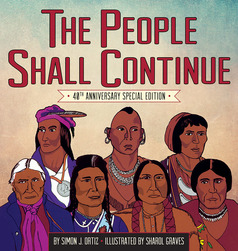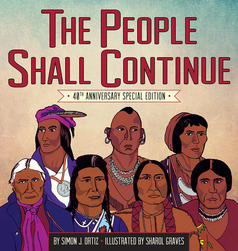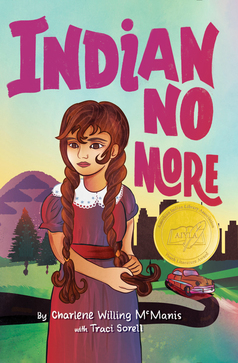Throughout American history, Native people have been intentionally silenced; their stories set aside, hidden, or drowned out. That’s why it’s critical to read stories about Indigenous characters, told by Indigenous voices. Teaching Indigenous history is essential all year-round.
Katie Potter, Senior Literacy Manager, and Elise McMullen-Ciotti, editor at Tu Books and proud citizen of the Cherokee Nation, discussed the historical and curricular applications behind two award-winning Indigenous titles from Lee & Low:
The People Shall Continue by Simon J. Ortiz and illustrated by Sharol Graves
“The times call on all of us to share The People Shall Continue. Ortiz reminds us that we must come together to save our planet.” — Debbie Reese, Ph.D., Publisher of American Indians in Children’s Literature
Download the teacher’s guide and check out the Spanish edition, El pueblo seguirá!
Indian No More by Charlene Willing McManis and Traci Sorell
⭐ “What begins as a story of displacement quickly turns into a story of childhood fun and antics colored by Umpqua culture and the racial tensions of the civil rights movement set in the lively and culturally diverse city of L.A.” — Booklist, starred review
⭐ “Readers will be moved as they become invested in Regina’s predicament. Is she still Indian, American, or both—and what does that mean for her and her family?” — School Library Journal, starred review
Download the teacher’s guide and check out the Spanish edition, Indio no más!
Read on to learn about how to center past and present Native stories and acknowledge the contributions of Indigenous peoples throughout our history to the present day, in the classroom and beyond.
Katie: Elise, how can we set educators up for success when they teach about Native American Heritage Month in addition to Indigenous history?
Elise: There are so many Indigenous stories that could be told from all over the continent, so when we only talk about just one or two stories, we are leaving out a great deal. Also, Indigenous people have always been viewed within a historical framework and not a part of modern society. You might not be aware of it, but there are Indigenous people all around you: Indigenous neighbors and community members, teachers, librarians, friends, etc. It’s important for educators to create that contemporary context of Indigenous people—that we’re here and part of this world right now. It’s also important to emphasize that when teaching history in a classroom, Indigenous history is included in American history and humanity’s history, not separate from it.
Katie: How can educators use both The People Shall Continue and Indian No More in their relevant settings?
Elise: Using a book like Indian No More highlights the part of our history called the Termination Era which took place from 1953 to about 1968. This was the period where the US government ended their relationship with tribal nations, and sought to dismantle our communities, move us to urban cities, and assimilate us so completely that we’d disappear within the current American culture. This book shows how we can retain our culture despite efforts to prevent it from existing. It’s also an excellent book to discuss while teaching about the Civil Rights Era, since the Termination Era was running alongside those events. Who had rights? Who were citizens? Who could be considered a full person and a full American?
Using a book like The People Shall Continue is an opportunity to take an epic, timeless story and fill in the gaps that other historical books have left out. The People Shall Continue encapsulates all Native Nations and Indigenous peoples. It has been, and still is, a very meaningful book to Indigenous people around the country who were and are finally able to see their accurate histories reflected. We truly see our real selves in this book!
An interesting piece of historical context, which may be good for historical curricula, is that The People Shall Continue was originally published in 1977, a period of Indigenous people’s unification and solidarity after the Termination Era. Tribal restoration began in the late sixties, and this process is still ongoing. Our sovereignty continues to be under threat. This is not something that’s been or will be one and done. We’ve experienced hundreds of years of direct dismantalization of our cultures and histories, which makes these restorative and protective processes long and incredibly difficult. But, we persist.
Katie: Can you explain more about the history behind The People Shall Continue? Why is this such an important book?
Elise: Sure! The Restoration and Self-determination period began around 1968. That year, President Johnson gave a speech called “The Forgotten Americans,” where he emphasized partnership over paternalism and proposed that the US change its federal policy, and that previously terminated nations were at liberty to renew their government-to-government relationship with the US. Soon after, Indigenous people were included in the expansion of the Civil Rights Act of 1964 and the Indian Civil Rights Act was passed.
This book’s publication in 1977 is historically significant, since it reflects those changes in policy, where we were given liberty to speak and teach the truth about our history and culture. The book was printed less than ten years after these policies were enacted as well as the Indigenous occupation of Alcatraz, a protest led by Native people from 1969 to 1971.
Actually, this is another great historical moment to teach about! The Alcatraz occupation of 1969 was much like the Dakota Access Pipeline protests of 2016. Indigenous people came together to protest and take over Alcatraz, claiming it as Indian land in an attempt to bring awareness to our existence and our Indigenous rights, similar to the protest the drilling of the pipeline.
This is why this book is so meaningful to me personally. I was a child during this era. It was a time when our nations were coming together and defending ourselves, changing our situation, and taking back what had been literally stolen from us. When I was little and found this book in the library, it helped me not only feel seen, but as an Indigenous child, it gave me encouragement to live proud of my people and heritage.
Katie: We’d love to hear more about the award-winning novel you edited, Indian No More (winner of the 2020 American Indian Youth Literature Award for Best Middle Grade Book). Can you set us up with the history behind Indian No More?
Elise: Let me first tell readers a little bit about the book. It is set in the 1950s and follows a 10-year-old Umpqua girl, Regina, and her family after their tribal rights are terminated and they relocate from their reservation in Oregon to Los Angeles. There they are expected to assimilate, and Regina asks herself: if she is no longer on her tribal land, and her tribe has been “terminated,” is she still Indian? Or is she “Indian no more?” Indian No More asks the essential question: “Who gets to say who you really are?”
This book actually covers a lot of American history and what was happening to Indigenous citizens at the time: the Termination Era, the Indian Relocation Act, and the Indian Relocation Program. Teachers will be quite happy with its extensive back matter with glossaries and histories. And again, as I mentioned, these were happening during the Civil Rights Era.
Although the book ends just one year after Regina moves to Los Angeles, there was good news for Regina’s tribal nation in the years ahead. On November 22, 1983, after nearly thirty years of termination, President Reagan signed House Resolution 3885, also known as Public Law 98-365. This law restored The Confederated Tribes of the Grand Ronde Community as a federally recognized Tribe.
But maybe you are asking about the history of the creation of the book? That is also a very special story. Traci Sorell, a fellow Cherokee citizen and a friend of mine and the author Charlene Willing McManis, finished the manuscript after Charlene’s passing in 2018. Charlene had wanted everyone to know that this history occurred, especially with young readers. And Traci did an amazing job fulfilling Charlene’s dream.
Traci and I truly embraced the Cherokee concept of “gadugi” during the creation of this book. Gadugi, or ᎦᏚᎩ, is a word that can be roughly translated to mean “the community works cooperatively for the common good,” or maybe a shortened version but with less meaning and nuance would be “working together.” Another way to describe gadugi is that we take care of one another and look after one another with respect and consideration. We’ve used the term often to name our crisis centers or clinics, and during the pandemic, this was the name we gave our nation’s online portal to distribute aid to our citizens. It’s a long and deep Cherokee tradition to care for one another and acknowledge our interdependence.
So it was a collective group of Indigenous people that brought the book to life after Charlene’s passing. We worked with the Confederated Tribes of Grand Ronde, and particularly the Umpqua culture keepers, to honor their community with the book. We wanted Umpqua kids to see themselves in the book and for the community to be able to hold us accountable as storytellers and make sure we got it right.
Katie: How can educators frame their conversations with young people when discussing The People Shall Continue and Indian No More?
Elise: I would say that educators can use both of these books to help create a modern Indigenous context for students. They are realistic, honest, and contemporary stories (post 1950s) perfect for their classroom libraries. These two books continue to reiterate that Indigenous people are still part of our larger communities and the world.
These stories also give educators a way to include universal themes like gratitude and community building. Relationships are key to Indigenous peoples’ way of being and philosophies.
Beyond these books, educators can teach students about how Indigenous people have been and still are highly knowledgeable and skilled in areas of trade, ecology, governing, languages, and all kinds of artisanal work. For example, before settler arrival (and after), we used sign language, we were experts in all kinds of agriculture, and we had large trading networks between tribal nations. Even the US constitution refers to the trade that existed between the nascent US government and our tribal nations.
Unfortunately, our contributions are still unnoticed and silenced within our institutions and our American culture. That’s why we need to work with Indigenous communities in recognizing their inventions and contributions. For example, companion planting and innovative fishing practices. Wouldn’t it be great to teach kids how to make a hammock? And then talk about how the Taíno created it? (We also have a YA book honoring Taíno people, The Moonlit Vine and its Spanish edition, Claro de luna!) Additionally, focusing on today’s Indigenous culture brings even more values to the stories we tell during Native American Heritage Month.
Finally, for educators covering local history, state history, and national history, I would encourage teachers and librarians to ask themselves: what was going on in Indigenous communities during this time? How can I incorporate those histories into the unit that we’re currently working on?
I’m so glad these two books have become a part of many educators’ classroom libraries. By doing so, educators have acknowledged that we’re still here and have much to contribute! I hope these stories continue to help them do the critical work of uplifting, sharing and promoting Indigenous histories, both past and present.
Katie: Thanks so much for chatting with me about this today, Elise.
Elise: My pleasure! I hope it helps educators out there.

Elise McMullen-Ciotti (she/her) is the editor of Tu Books, the middle grade and young adult imprint of Lee & Low. She worked on such titles as Indian No More (AIYLA winner), Julieta and the Diamond Enigma (New Visions Award winner), and Black Was the Ink (Grateful American Book Prize). Elise is also an author and food scholar at NYU Steinhardt. Her academic research at NYU focuses on the role food plays in the healing of a people, the regenerative and the restorative efforts of Indigenous foodways, and Indigenizing curriculums. As a children’s book author, some of her books and stories include Kanuchi Day and Hedge Over Heels (Scholastic) as well as “Cannibal at the Door” in Calling the Moon (Candlewick Press) with more books on the way with Abrams and Scholastic. Elise is a proud member of the Cherokee Nation and grew up in Texas. Today, she lives in New York City with her husband, a large personal library, and an open kitchen.

Katie Potter (she/her) is the Senior Literacy Specialist at Lee & Low Books. She is responsible for writing and developing the rigorous Teacher’s Guides and Educator Resources for all frontlist titles, in addition to working with university professors and nonprofit organizations on how to incorporate diverse, multicultural literature into curriculum and syllabi. Prior to Lee & Low, Katie worked as an educational researcher, teacher, and literacy instructor. Katie has a dual Bachelor’s Degree in Psychology and Spanish from Skidmore College and a Master’s Degree in Childhood General Education Grades 1-6 and Literacy from Bank Street College of Education.











